ERA Country Report 2023
Slovakia
Edited by Vladimir Balaz (Independent Science, Technology and Innovation policy expert)
as part of ‘Development of the ERA Scoreboard, the ERA Dashboard and the Regular Reports’ project for the European Commission, Directorate-General for Research and Innovation under Framework Contract N° 2018/RTD/A2/OP/PP-07001-2018 Lot 2 (EDAR)
Click here to download this country report![]()
- Table of contents
-
ERA Country Report 2023: Slovakia
1. National context
1.1. Overview of the ERA policy agenda implementation
1.2. Policy context
2. Assessment of the Implementation of the ERA Policy Agenda and ERA Priorities
2.1. ERA Priority 1: Deepening a truly functional internal market for knowledge
2.2. ERA Priority 2: Taking up together the challenges posed by the twin green and digital transition and increasing society’s participation in the ERA
2.3. ERA Priority 3: Amplifying access to research and innovation excellence across the Union
2.4. ERA Priority 4: Advancing concerted research and innovation investments and reforms
3. Country-specific drivers and barriers
4. Final remarks
5. Bibliography
6. Annexes
6.1. Annex 1: Graphs
ERA Country Report 2023: Slovakia
|
Key takeaways:
|
1. National context
1.1. Overview of the ERA policy agenda implementation
Slovakia is ranked as Emerging Innovator in the European Innovation Scoreboard 2023 (EIS), with performance at 65.6% of the EU-27 average. The gap between Slovakia and EU average increased during the recent years.
Slovakia has committed to 11 ERA Actions. The National strategy for research, development and innovation 2030 (NSRDI 2030) is the key research and innovation (R&I) policy document. It focuses on reform of R&I system and also is the key document implementing most of the ERA Actions. The Action Plan for the NSRDI 2030 specifies contents and work plans for individual policies envisaged in the strategy. The Annex to the strategy identifies expected return on investments to R&I in terms of economic growth. The NSRDI 2030 document implements schemes envisages by Slovakia’s Recovery and Resilience Plan (RRP), Components 9 and 10.
Other documents important for implementation of the ERA Policy Agenda include the Research and innovation strategy for smart specialisation of the Slovak Republic 2021-2027, the National Strategy for Open Science (and associated Action Plan) and the Digital Transformation Strategy. The public funding dedicated to R&I remained heavily dependent on the European funding. The Partnership Agreement ^ and the Operational Programme Slovakia set targets and thematic areas for the ESIF funding.
1.2. Policy context
Slovakia’s R&I system is fragmented into a high number of government bodies and agencies. The key division runs between the Ministry of Education, Science, Research and Sports (MESRS) ^ and the Ministry of Economy. Each ministry manages its system of R&I funding agencies. The MESRS is the key body for designing and implementing R&D policies. ^ It is responsible for: (i) drafting national programmes for development of science & technology (S&T); (ii) international co-operation and membership in international research bodies (in the EU-area in particular); (iii) designing tools for direct and indirect support to R&I; (iv) drafting annual report on R&D; and (v) compiling budget for the Slovak Research and Development Agency (SRDA).
The SRDA is an agency distributing public funding for research projects and supporting Slovakia’s participation in the EU-wide research programmes and initiatives. The MESRS manages funding agencies for basic research (VEGA), culture and education activities (KEGA), basic and applied research (SRDA), and the Research Agency, in charge of the implementation of the ESIF programmes in the field of R&I. Furthermore, the Slovak Centre of Scientific and Technical Information (SCSTI) and its liaison office Brussels (SLORD) are also crucial for the engagement of the country in Horizon Europe, and the mentoring schemes in the R&I internationalisation area.
The Centre for Scientific and Technical Information of the Slovak Republic (SCSTI) is a public national information centre specialised in science, technology, innovation and education managed by the MERS. The MESRS manages 35 higher education institutions (HEIs), being 20 of them public. The MESRS also implements the R&D stimuli scheme. ^ The Slovak Government Council for Science, Technology and Innovations (SGCSTI) is a body coordinating R&I policies in Slovakia. The Slovak Academy of Sciences (SAS) is the prime research performer. It contains 45 research centres and institutes.
The Ministry of Economy manages a network of agencies supporting innovation: the Slovak Business Agency (SBA) and the Slovak Innovation & Energy Agency (SIEA). The SIEA implements ESIF resources in the field of innovations, while the SBA channels European funding to business support programmes. In addition, the Research and Innovation Authority (RIA) was established with the Government Office in 2022. The RIA’s mission is to “draft and co-ordinate research and innovation policies as to transform Slovakia to an ambitious and innovative country”.
2. Assessment of the Implementation of the ERA Policy Agenda and ERA Priorities
Chapter 2 has two objectives: 1) It qualitatively assesses the state-of-play of the implementation of the ERA actions that Slovakia has committed to; 2) It quantitatively assesses the country’s progress towards achieving the ERA priorities as set out on the Pact for Research and Innovation in Europe. The key data sources used include: (a) international databases including European Innovation Scoreboard, Eurostat data on Science and Technology; (b) the OECD STIP survey; (c) policy reports such as the 2023 European Semester Report for Slovakia; the 2023 National Reform Programme for Slovakia, the Slovak 2022 Annual Report on R&D; ^ (d) the key Slovak national documents on R&I policies and (e) ERA Scoreboard and ERA Dashboard indicators.
| Indicator |
Most recent EU average |
Most Recent Metric |
| Gross Domestic Expenditure on R&D (GERD) as a percentage of GDP |
2.26 (2021) |
0.93 (2021) |
| Government Budget Allocations for R&D (GBARD) as a share of GDP |
0.76 (2021) |
0.41 (2021) |
| Researchers (in full-time equivalent) per million inhabitants |
4,481.4 (2021) |
3,208.7 (2021) |
| Business Enterprise expenditure on R&D (BERD) as a percentage of GDP |
1.49 (2021) |
0.5 (2021) |
Source: compiled by research team based on the ERA Scoreboard and ERA Dashboard indicators
2.1. ERA Priority 1: Deepening a truly functional internal market for knowledge
2.1.1. State of play in the implementation of the ERA Actions
To implement ERA Action 1: Enable the open sharing of knowledge and the re-use of research outputs, including through the development of the European Open Science Cloud (EOSC), the Slovak Government passed the 2021-2028 National Strategy for Open Science and a respective 2021-2022 Action Plan. This strategy and action plan support digital infrastructure for open science and its integration within EOSC, while promoting open science for all, including citizens and targeting open access to research results and scientific data, technical infrastructure, financial support and intellectual property rights for open science.
Already in 2011, the Slovak Government joined the Open Government Partnership, that encourages the principles of open governance, open access, participation of stakeholders in public policies and increase transparency. The Slovak Centre of Scientific and Technical Information (SCSTI) is the Mandated Organisation to the EOSC Association and works as the main national information centre. It uses ESIF resources to provide open access to scientific knowledge and major scientific databases. ^
The ERA Action 2: Propose an EU copyright and data legislative framework for research is addressed via the National Strategy for Open Science 2021-2028 and a respective Action Plan 2021-2022 as part of the Open Government Initiative mentioned above. In this sense, it promotes transparency and integrity in the open availability of scientific data in accordance with the European principles of access and preservation of scientific findings. The RIA plans to use matching grants to support licensing and intellectual property rights related to industry-academia projects. ^
The ERA Action 3: Reform the Assessment System for research, researchers and institutions is related to the NSRDI 2030 strategy and the 2023 National Reform Programme of the Slovak Republic 2023. The ongoing reform of the institutional funding introduces stricter assessment criteria for the Slovak HEIs and public research organisations (PROs). The international panels of experts must apply the ‘verification of excellence in research’ principle to evaluate performance of HEIs and PROs.
The HEIs and PROs will sign ‘three-year performance contracts’ with the MESRS and their accreditation and funding will depend on the results of the assessment. The contracts would consider quality of research and teaching, but also co-operation with the private sector, gender equality, academic integrity, and diversity and inclusion. The SAS research institutes will sign similar contracts with the SAS Board.
The ERA Action 4: Promote attractive research careers, talent circulation and mobility is covered by the NSRDI 2030 strategy. ^ The strategy suggests a number of policies aimed at promotion of attractive research careers. Most support schemes were launched in 2023. Additionally, Component 9 of the RRP implemented policies supporting the ERA Policy Agenda in 2023: (i) support to excellent PhD students, (ii) support to excellent researchers and (iii) support to excellent researchers affected by the Ukrainian war. Other policy measures are under preparation and include the ERC visiting grants, the ERA transition grants, support to preparation of the Horizon Europe proposals, support to the Seal of Excellence projects, and matching grants to Horizon Europe projects.
Component 10 of the RRP also implements measures on attracting talent. The NSRDI 2030 ^ strategy also acknowledges the most serious problem of the Slovak R&I system, which is a significant brain drain, and emigration of the Slovak university students and young researchers. It proposed creating the Talent Unit with the Slovak Government Office. Moreover, the SRDA grants provide direct support to research careers. Participation in national and international research infrastructure projects enhances international, transdisciplinary and inter-sectoral mobility by talented researchers. The Higher Education Internationalisation Strategy by the year 2030 ^ focuses on ‘increasing the availability of an international experience during studies and modernisation of educational process in the context of an internationalisation’.
The ERA Action 8: Strengthen sustainability, accessibility and resilience of research infrastructures in the ERA is implemented through the Roadmap 2020-2030, which is the key Slovak document on international research infrastructures. The MESRS updated the Slovak ESFRI 2020-2030 roadmap in March 2021. As for the national infrastructures, the Data Centre for R&D stores and provides data for researchers.
In addition, the NSRDI 2030 is key for the development of ERA Action 8. It encouraged the establishment of the Office for Research Infrastructure and the launch of schemes supporting Slovakia’s participation in the ESFRI initiatives. The office should co-operate with the SGCST. NSRDI 2030 also set that financial rules for sustainability of the large infrastructures would operate ‘in the mid-term horizon’. The rules should set standards for evaluation of the infrastructure effects and synergies, that would be supported via grants and financial instruments.
2.1.2. Progress towards achieving ERA Priorities
Regarding Sub-priority 1.1: Open science, Figure 5 in Annex 1 illustrates that 30.78% of the total Slovak scientific publications (with DOI) accounted for open access in 2019, below EU-27 average which was 39.17% in the same year.
Moreover, for Sub-priority 1.2: Research Infrastructure, the share of national public R&D expenditure allocated to European research infrastructures shows that the value for Slovakia is of 1.96% and hence, slightly higher than the European Average of 1.82%. ^ Moreover, the country was a full member in eight and a guest member in four projects of the European Strategy Forum on Research Infrastructures (ESFRI) (Figure 6 in Annex 1).
There are several indicators on Sub-priority 1.3: Gender equality, equal opportunities for all and inclusiveness. The share of women in grade A positions in higher education institutes was the same in Slovakia and the EU-27 period 2010-2018 (Figure 7 in Annex 1). The proportion of women among doctoral graduates by narrow fields of Science, Technology, Engineering and Mathematics (STEM) increased from 41.6% to 46.7% in Slovakia, remaining above the EU-27 during the period between 2013-2020 (Figure 8 in Annex 1). The proportion of papers with mixed gender authorship was lower in Slovakia than in the EU-27 both in 2010 (48.3% vs 52.3%) and 2020 (59.5% vs 62.7%) (Figure 9 in Annex 1).
As for the proportion of women in authorships of the 10% most cited publications, the gap between Slovakia and the EU-27 widened in period 2010-2018. The respective proportions increased from 34.1% to 40.4% in Slovakia while decreased from 28.0% to 32.6% in the EU-27 in the abovementioned period (Figure 10 in Annex 1). The value of the ‘Women in Digital’ index was substantially lower in Slovakia (48.0) than in the EU-27 (57.2%) in 2022 (Figure 11 in Annex 1).
In Sub-priority 1.4: Careers and mobility of researchers and research assessment and reward system, the share of foreign doctorate students as a percentage of all doctorate students increased from 9.1% to 11.6% in Slovakia between 2015-2020 but remained below EU-27 average which increased from 16.3% to 23.3% during the same period (Figure 12 in Annex 1). The number of new doctoral graduates in age group 25-34 per 1,000 inhabitants decreased from 0.9 to 0.6 between 2013-2020 with similar trends observed at EU-27 level (Figure 13 in Annex 1). The indicator on job-to-job mobility of human resources in science and technology for Slovakia increased slightly between 2010-2020 to 3.4% but remained below EU-27 average at 6.8% in 2020 (Figure 14 in Annex 1).
As for Sub-priority 1.5: Knowledge valorisation, the share of public-private co-publications per million population, Slovakia was unable to close to gap with the EU-27 in the period 2011-2021. The respective shares increased from 52.3 to 111.4 in Slovakia, but from 86.4 to 133.9 in the EU-27 (Figure 15 in Annex 1). Slovakia also was unable to close substantial gap with the EU-27 in indicator on number of PCT patent applications divided by GDP (in million Euros). The respective values changed from 0.00071 to 0.00076 in Slovakia, while from 0.0042 to 0.0029 in the EU-27 in period 2010-2015 (Figure 16 in Annex 1).
As for the indicator on business enterprise researchers (as % of national, total), gap between Slovakia and the EU-27 remained substantial in period 2010-2020. The respective shares increased from 12.7% to 24.6% in Slovakia, but from 47.2% to 55.3% in the EU-27. The number of business enterprise researchers in FTE per thousand employment in industry, increased from 1.14 to 2.26 in Slovakia, but remained below EU-27 average which increased from 4.38 to 6.89 between 2010-2020. While absolute numbers of business researchers increased, the gap between the Slovakia and EU-27 widened in the last decade (Figure 18 in Annex 1). The share of innovating firms collaborating with higher education institutions or public/private research institutions decreased from 12.1% to 11.8% in Slovakia but increased from 10.9% to 13.3% in the EU-27 in the period 2010-2020 (Figure 19 in Annex 1).
Slovakia made some progress towards Sub-priority 1.6: Scientific Leadership. The number of scientific publications among the top-10% most cited publications worldwide as a percentage of all publications increased from 2.9% in 2010 to 4.5% in 2020. The respective EU-27 average reduced from 10.1% to 9.8% (Figure 20 in Annex 1). The absolute gap in excellence research, however, remained substantial and Slovakia accounted for the second lowest shares of top-10% most cited publications in the EU-27. Value of the Academic Freedom Index (Figure 21 in Annex 1) decreased from 0.953 to 0.947 in Slovakia, but from 0.936 to 0.888 in the EU-27 in period 2010-2022.
Finally, Sub-priority 1.7: Global engagement. The number of international co-publications with non-EU partners per 1,000 researchers in the public sector increased from 390.7 to 827.8 in Slovakia while from 660.2 to 1,278.9 in the EU-27 in period 2010-2022 (Figure 22 in Annex 1). Intensity of European and international co-patenting in EPO applications at national and EU level was vastly different between Slovakia and the EU-27. The intensity decreased from 32 to 20, but from 1,799.3 to 1,460.7 patents in the EU-27 in period 2010-2013 (Figure 23 in Annex 1).
2.2. ERA Priority 2: Taking up together the challenges posed by the twin green and digital transition and increasing society’s participation in the ERA
2.2.1. State of play in the implementation of the ERA Actions
The ERA Action 10: Make EU R&I missions and partnerships key contributors to the ERA, is implemented through participation in the ECSEL JU (Electronic Components and Systems for European Leadership Joint Undertaking) according to 2022 Slovak Annual Report on Research and Development. Slovakia participated in nine projects and contributed EUR 0.8 million to ECSEL in 2021. Participation in the ESFRI projects described above also enhances implementation of the ERA Action 10.
With regard to ERA Action 11: An ERA for green energy transformation, the Slovak Government passed the Integrated National Energy and Climate Plan for 2021-2030. ^ The plan addresses decarbonisation, energy efficiency & security, and research and innovation in energy and climate action. The update of the plan is under preparation and the new version of the plan is expected in 2024.
Additionally, the National Hydrogen Strategy published in 2021 aims at implementation of the hydrogen-based technologies in the Slovak economy in period 2021-2030. The Slovak government wants to support research and innovations in hydrogen technologies as to support green transformation in transport, industry and energy sectors. The Slovak RRP addressed the challenges on energy, and the circular economy with calls to de-carbonise the economy. One call allocated EUR 15 million to research projects on energy storage, and hydrogen and other alternative fuels in 2023.
As for ERA Action 12: Accelerate the green/digital transition of Europe´s key industrial ecosystems, the Slovak Government approved the Digital Transformation Strategy 2030 and the Slovak Action Plan for Digital Transition for 2023-2026. The strategy presents a general vision of Slovakia in 2030: ‘The Slovak Republic transforms to a modern country with innovative and ecological industries and knowledge-based digital and data-based economy’. ^ The Action Plan focuses on supporting the digitalisation of businesses and broader economy. It promotes overall competitiveness, and productivity growth in the knowledge-based economy and sectors with high added value. It also supports society development and resilience towards harmful impacts by digital technologies. The green transition is supported via implementation of the National Hydrogen strategy.
Implementation of ERA Action 13: Empower Higher Education Institutions to develop in line with the ERA, and in synergy with the European Education Area is empowered via the Strategic Plan for development of educational, research, artistic and other creative activities in higher education. It targets five areas of higher education related to diversification of HEIs, support for students, public HEIs, open science and education, and career development.
The Slovak Accreditation Agency for Higher Education was established in 2018 to perform external quality assurance activities in higher education. The agency implements the European Standards for Quality Assurance in Higher Education (ESG 2015). The reform of institutional funding for the Slovak HEIs and PROs also contributes to synergies with education and the European Skills Agenda. Similarly, the Slovak Government passed the Higher Education Internationalisation Strategy by the year 2030. The strategy is linked to measures envisaged by RRP and provides a tool to increase quality of education and research in HEIs by 2030 to improve the Slovak performance in the area of education.
Therefore, the Slovak RRP envisages the reformation of the higher education system and has allocated EUR 213.3 million to support reforms listed in the NSRDI 2030 document. ^ This assessment helped to identify HEIs with top performance in science and artistic subjects. The reform argues that research and higher education are fragmented into high number (over 30) of the HEIs. It also envisages to create two large University consortia, arguing that it would be more visible in the World University rankings and may obtain higher funding. The consortia are expected to stop brain drain by Slovak students, and to enable full integration of consortia members to two large Slovak Universities by 2026.
As for the ERA Action 14: Bring Science closer to Citizens, the NSRDI 2030 document mentions citizens’ interest in science, technology and innovation. ^ Popularisation of science, rather than citizen science, is addressed. The target is to ‘increase young people interest in science and career in science’ and ‘improve positive attitudes towards science and innovation’. The Ministry of Economy supports Action 14 via prizes and competitions such as ‘Innovative Project of the Year’ and ‘Young Designer’, while MESRS and SCSTI via shows and events such as the European Researchers' Night and Week of Science and Technology.
2.2.2. Progress towards achieving ERA Priorities
Regarding Sub-priority 2.1: Challenge-based ERA actions, the Government Budget Allocations for R&D (GBARD) by NABS in energy; transport, and telecommunications and other infrastructure fluctuated between 2010 and 2021, when they registered a value of EUR 3.7 million and EUR 5.4 million respectively. When looking about the GBARD allocation for environment, Slovakia increased consistently during the analysed period, going from a EUR 5.3 million in 2010 to a EUR 11.6m in 2021. Still, the country remains in all three areas below the EU-27 average during the period (Figure 24 in Annex 1).
The Slovak environmentally related government R&D budget accounted for 3.19% of total government R&D outlays and was higher in relative terms than the EU-27 average (1.98%) in 2021. The share remained relatively stable in the last decade (Figure 26 in Annex 1). The public and private investments as suggested in the SET Plan progress report 2021, however, were quite low in absolute terms in Slovakia (Figure 27 in Annex 1), compared to the EU-27 average. Slovakia’s performance in the OECD Patents on environment technologies indicator was quite volatile, with no clear trend during the period between 2010-2021 (Figure 28 in Annex 1).
The GBARD allocated to Europe-wide transnational, as well as bilateral or multilateral, public R&D programmes per FTE researcher in public sector increased tenfold during the period between 2010-2021 in Slovakia, albeit from a very low base. The gap between Slovakia and the EU-27 has narrowed over time (Figure 25 in Annex 1). This might be related to Slovakia’s spending on the European Space Agency and CERN programmes.
Sub-priority 2.2: Synergies with education and the European Skills Agenda is represented in Figure 29 in Annex 1 which shows that 42.7% researchers received transferable skills training in Slovakia compared to 46.3% in the EU-27 in 2019. In relation to Sub-priority 2.3: Synergies with sectorial policies and industrial policy, in order to boost innovation ecosystems, grants and tax incentives are standard tools for support to business research in the EU-27 area. Direct and indirect government support through R&D tax incentives increased from 0.0274% to 0.0601% GDP in Slovakia, compared to the increase from 0.1503% to 0.1815% GDP in the EU-27 average during the period between 2010-2020 (Figure 30 in Annex 1).
Sub-priority 2.4: An active citizen and societal engagement in R&I in all its dimensions is considered through two indicators. The trust in science indicator shows that 41.5% of citizens had trust in science in Slovakia in 2021 just below the EU-27 average of 43.2% (Figure 31 in Annex 1). The number of publications on “social innovation” or “social entrepreneurship” per million population varied considerably between 2011-2021 in Slovakia but was at similar levels in 2021 compared to a decade ago (Figure 32 in Annex 1). As the EU-27 average increased, the gap between Slovakia and the EU-27 has widened over time.
2.3. ERA Priority 3: Amplifying access to research and innovation excellence across the Union
2.3.1. State of play in the implementation of the ERA Actions
Slovakia did not commit to ERA Action 16: Improve EU-wide Access to excellence, but the NSRDI 2030 document acknowledged the challenge and has set a target ‘to increase number of scientific publications among the top-10% most cited publications worldwide’ to 8% by 2030’. ^ The indicator is included in a set of binding monitoring indicators for allocation of institutional, project and infrastructure finance.
The NSRDI 2030 document aims to support the EU-wide access to excellence via the ERC visiting grants, the ERA transition grants, the Seal of Excellence projects, matching grants to Horizon Europe projects, and assistance to preparation of the Horizon Europe proposals. Access to excellence also is promoted via collaborative projects on large research infrastructures, and national support to bilateral and multilateral science and technology projects.
As regards the implementation of ERA Action 17: Enhance the strategic capacity of Europe´s public research performing organisations, the NSRDI 2030 strategy introduces reform of institutional finance for PROs. ^ The document notes that ‘grant-based institutional finance is a sub-optimal instrument, as it is demanding on evaluation and monitoring’ and ‘long-term quality assessment exercises’ by international panels of experts. The exercises would include both bibliometric measures and indicators on social and commercial relevance of the research. The ‘verification of excellence in research’ (VER) is the key assessment method and performance contract the key form of finance for the PROs. ERA Action 17 is also supported via PROs’ participation in the research infrastructure projects, SRDA grant programmes. Horizon Europe projects and the National Scholarship Programme.
2.3.2. Progress towards achieving ERA Priorities
Sub-priority 3.1: More investments and reforms in countries and regions with lower R&I performance is analysed in Figure 33 in Annex 1. The average annual increase of total R&D expenditure expressed as a percentage of GDP in Slovakia experienced important fluctuations but ended up reaching a 0.04% in 2021. For the EU-27, although the trend remained relatively stable, the results in 2021 were -0.04%.
2.4. ERA Priority 4: Advancing concerted research and innovation investments and reforms
2.4.1. State of play in the implementation of the ERA Actions
Although Slovakia is not committed to the ERA Action 19: Establish an efficient and effective ERA monitoring mechanism, the Statistical Office of the Slovak Republic works as the central instrument of monitorisation in the country. It regulates the statistical data collection, administration and evaluation in various areas, including science, technology and innovation, research entities, and the innovation activity of enterprises.
2.4.2. Progress towards achieving ERA Priorities
Sub-priority 4.1: Coordination of R&I investments is represented by the share of public R&D expenditures financed by the private sector which has declined in Slovakia over the last decade (Figure 34 in Annex 1). The value for Slovakia was around 7.9% in 2010, but after some fluctuations, it started to decrease in 2018 and reached a 2% in 2020. Slovakia’s universities became over-reliant on the government and EU funding and largely insulated from co-operation with business sector.
3. Country-specific drivers and barriers
The implementation of the ERA in Slovakia has been gradually improving in the recent years, and therefore, the analysed indicators show a general increase. However, the country is still below the EU-average in many areas. Therefore, some challenges need to be addressed to improve the R&I position of Slovakia.
One of the main challenges for Slovakia in this regard, is the history, size and structure of the Slovak economy. The difficult economic transition that the country experienced in the 1990s promoted urgent reforms rather than developing long-term plans. This has led the country to depend to some extent on the international market, foreign-owned sector, and the multinational companies (MNCs). ^ The MNCs did research in their headquarters and proved limited interest in shifting their applied/industrial research to Slovak HEIs and PROs. Still, the academia and industrial sectors have lacked cooperation and therefore, the R&I system has been considered to be weak and fragmented. What is more, Slovak HEIs and PROs became over-reliant on generous EU funding and lost interest in co-operation with domestic SMEs over time. ^
The investments are directly related to the ESIF funding, but the results were ambiguous. European assistance helped to build/modernise Slovak research infrastructures. ^ Impacts of these investments, unfortunately, have not been seen in adequate R&I outputs so far. The annual EIS,[ European Semester Report[ and National Reform Programmes reports repeat observations on Slovakia’s mediocre performance in terms of innovation outputs. The ESIF infrastructure investments may have overshadowed some other important policy agendas, such as substantial brain drain by young and talented students and researchers, and/or Slovakia’s participation in the European and global R&I programmes. What is more, the ESIF investments were not matched with much-needed reforms of R&I governance till 2022. Fragmented system of support to R&I, and ineffectual system of research assessment in HEIs and PROs impacted efficacy of the European funding.
The 2023 European Semester Report for Slovakia mentions ‘low intensity of research and development’ (R&D), ‘dissatisfactory implementation of European Structural and Investment Funds (ESIF) in R&I thematic area, several de-commitments hindering the flow of resources to R&I beneficiaries’ as well as ‘mediocre results in terms of innovation outputs and business innovation performance’. The report also observed that ‘a weak public research system and low-quality scientific outputs constitute a major barrier to better performance for the R&I ecosystem. The low quality of the scientific base also results in a low ability to retain researchers and attract students.’ The report acknowledges that Slovakia’s RRP aims at introducing a system of periodic scientific performance evaluations for universities, to improve the quality of their scientific performance.
4. Final remarks
Slovakia has committed to 11 ERA Actions under the ERA Policy Agenda. Slovakia adopted several policies targeting specific ERA actions (open science, ESFRI Roadmap, green and digital transformation). The national research infrastructures have been prioritised in terms of the total EU-assisted spending.
Although Slovakia has performed above the EU-27 average in areas as women in STEM (1.3) or academic freedom (1.6), areas in which the country has been increasing, further efforts have to be taken to improve the context of R&I in the country. Specially in terms of open science (1.1), research infrastructures (1.2) and social engagement in society (2.4) the data registered leaves room for improvement. The NSRDI 2030 document and the RRP interventions help to implement some much-needed reforms of the R&I governance, such as setting system of periodic evaluation of scientific performance and conducting research assessment in HEIs and PROs. In addition, the country has been developing initiatives as the National Strategy for Open Science 2021-2028, the Roadmap 2020-2030, or the Higher Education Internationalisation Strategy to improve its R&I position in relation to ERA Priority 1. Similarly, the country has developed new initiatives to promote the green and digital transitions under ERA Priority 2.
Although Slovakia is still facing challenges in the R&I context, the increasing trends that most indicators have registered in the recent years is a key demonstration of the country´s commitment towards the ERA Policy Agenda. For this reason, the implementation of new policies at both national and international levels is expected to improve the progress in the close future.
5. Bibliography
European Commission (2023): 2023 European Innovation Scoreboard Country profile Slovakia
European Commission (2023): 2023 European Semester Report for Slovakia
European Commission (2023): Integrated Infrastructure. Programme Description
European Commission (2023): Slovakia’s National recovery and resilience plan – update April 2023
MESRS (2016): Operačný program Výskum a vývoj (The Operational Programme Research and Development)
MESRS, Slovak Ministry of Education, Science, Research and Sports (2021): MESRS Národná stratégia pre otvorenú vedu na roky 2021- 2028 (the National Strategy for Open Science)
MESRS, Slovak Ministry of Education, Science, Research and Sports (2022): Správa o stave výskumu a vývoja v Slovenskej republike za rok 2022 (2022 Annual Report in on Research and Development)
MESRS, Slovak Ministry of Education, Science, Research and Sports (2021): Cestovná mapa výskumných infraštruktúr - SK VI Roadmap 2020 – 2030 (Slovak ESFRI 2020-2030 roadmap)
MESRS, Slovak Ministry of Education, Science, Research and Sports (2021): Stratégia výskumu a inovácií pre inteligentnú špecializáciu SR (Research and innovation strategy for smart specialisation of the Slovak Republic 2021-2027)
Ministry of Finance (2023): The 2023 National Reform Programme of the Slovak Republic
MIRDI, Ministry of Investment, Regional Development and Informatisation (2019): Stratégia digitálnej transformácie Slovenska 2030 (Digital Transformation Strategy), Slovak Government Resolution no 206/2019 of 7 May 2019
MIRDI, Ministry of Investment, Regional Development and Informatisation (2022): Akčný plán digitálnej transformácie Slovenska na roky 2023-2026 (Action Plan for Digital Transition for 2023-2026), Slovak Government Resolution no 800/2022 of 14 December 2022
OECD (2023): The OECD STIP survey
Slovak Government Office (2022): Partnerská dohoda na roky 2021 – 2027 (The Partnership Agreement for 2021-2027)
Slovak Government Office (2022): Program Slovensko 2021 – 2027 (The Operational Programme Slovakia 2021-2027) The Slovak Government Resolution no 87/2022 of 28 June 2022
Slovak Government Office (2023): Národná stratégia výskumu, vývoja a inovácií do roku 2030 (National strategy for research, development and innovation 2030)
Slovak Government Office (2023): Akčný plan pre Národnú stratégiu výskumu, vývoja a inovácií do roku 2030 (The Action Plan for the NSRDI 2030)
6. Annexes
6.1. Annex 1: Graphs
The 2023 ERA Scoreboard and ERA Dashboard indicators used in the country report are presented in this annex. Detailed information on the data sources, description of the indicators, time period for which the data is available, and the necessary calculations can be found in the ERA Scoreboard and ERA Dashboard Methodology Report. The most recent available data for each indicator has been used.
General Indicators
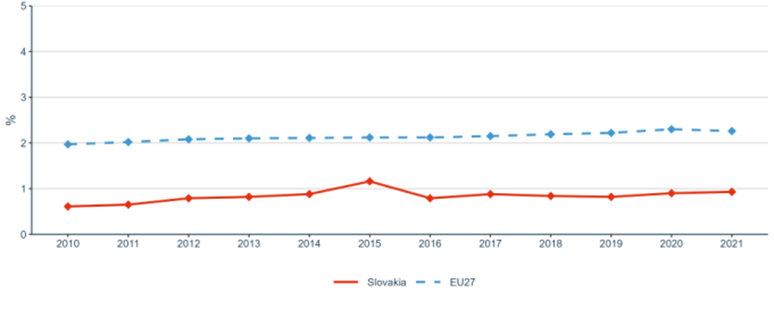
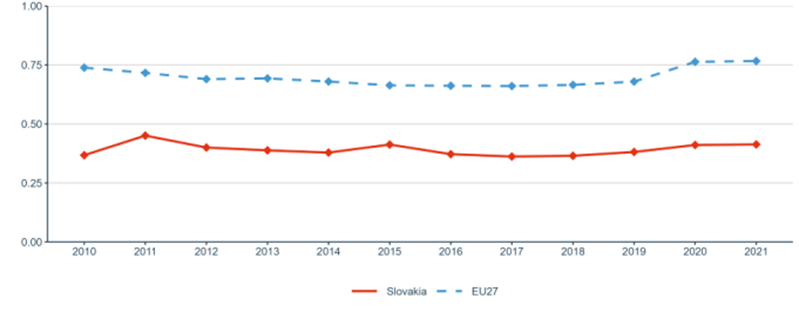

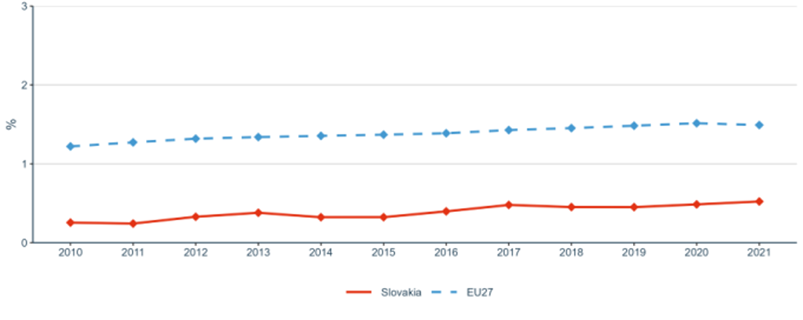
Priority 1: Deepening a truly functioning internal market for knowledge.
Sub-priority 1.1: Open Science
Sub-priority 1.2: Research infrastructures
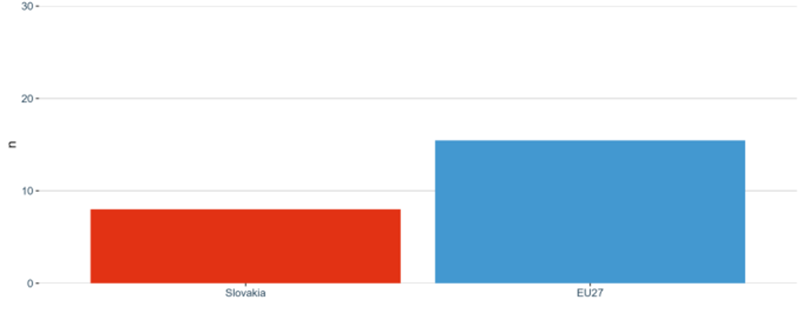
Sub-priority 1.3: Gender equality, equal opportunities for all and inclusiveness

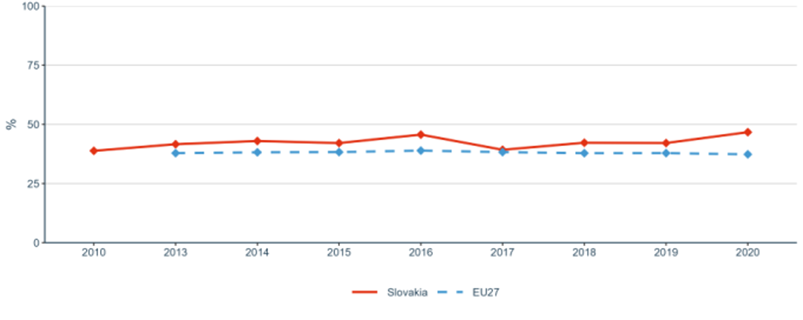



Sub-priority 1.4: Researchers’ careers and mobility and research assessment and reward systems
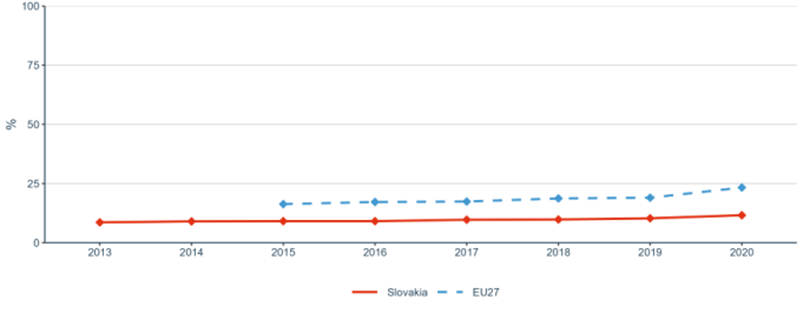
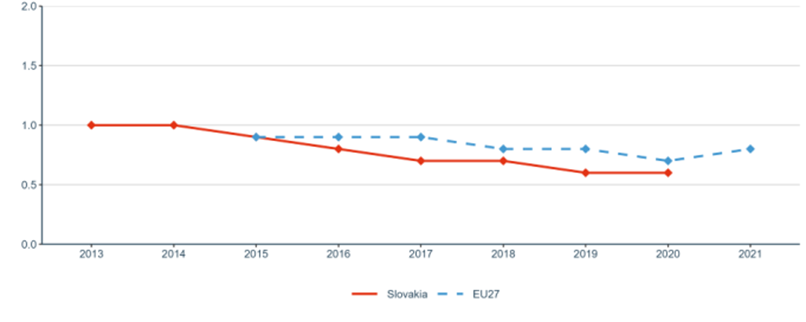
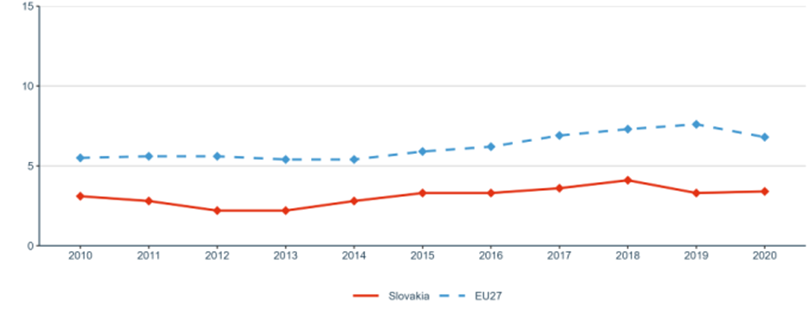
Sub-priority 1.5: Knowledge valorisation

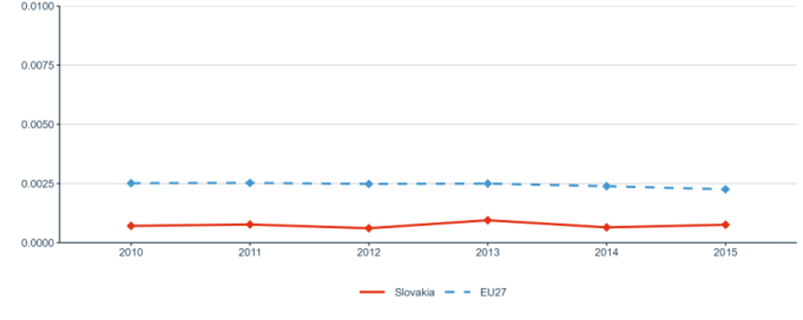
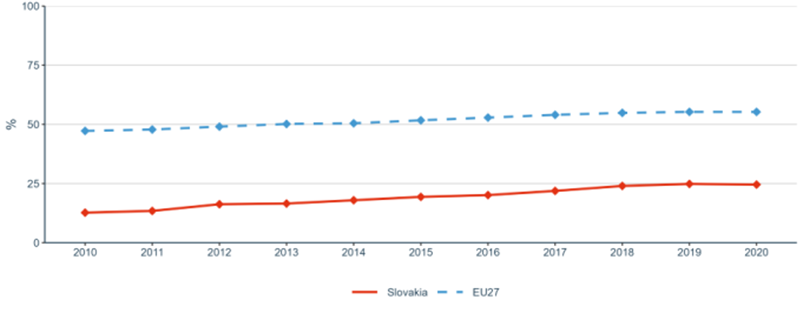
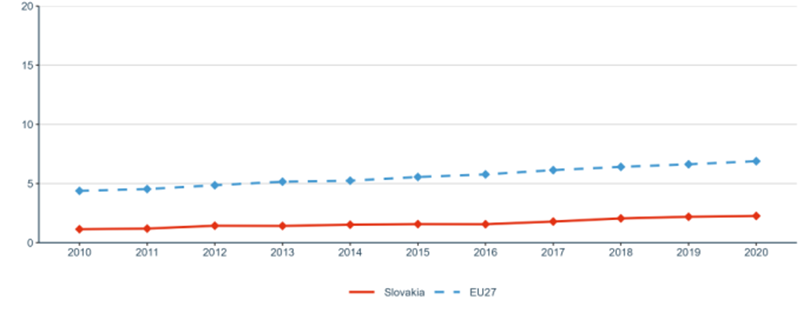

Sub-priority 1.6: Scientific leadership


Sub-priority 1.7: Global engagement
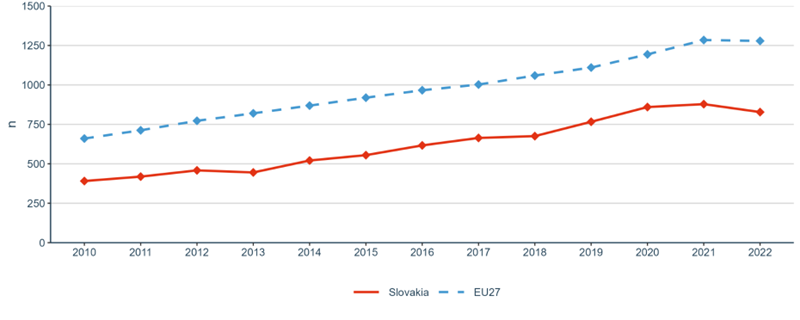

Priority 2: Taking up together the challenges posed by the twin green and digital transition, and increasing society’s participation in the ERA
Sub-priority 2.1: Challenge-based ERA actions
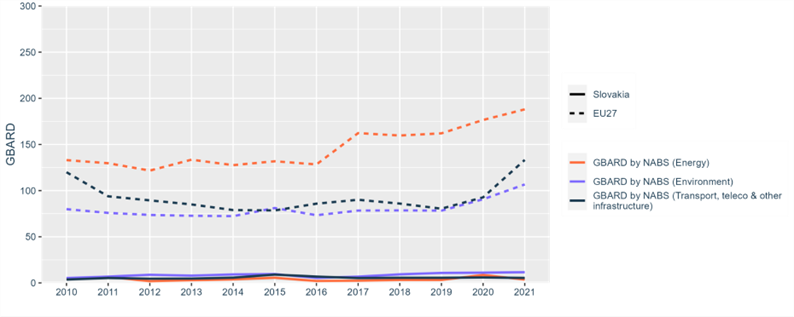
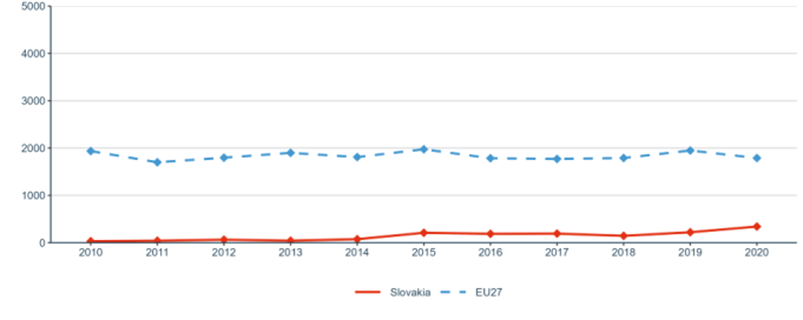

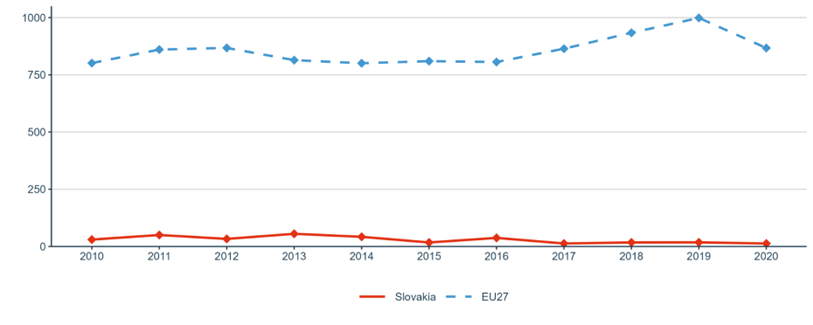
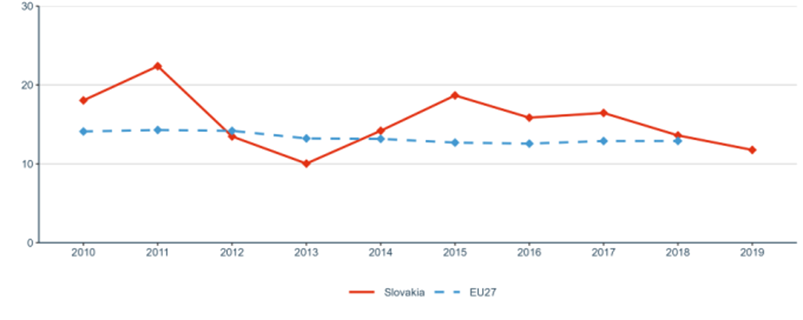
Sub-priority 2.2: Synergies with education and the European Skills Agenda

Sub-priority 2.3: Synergies with sectorial policies and industrial policy, in order to boost innovation ecosystems
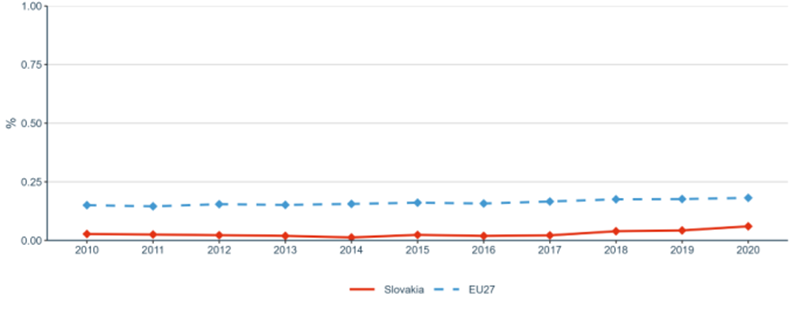
Sub-priority 2.4: An active citizen and societal engagement in R&I in all its dimensions

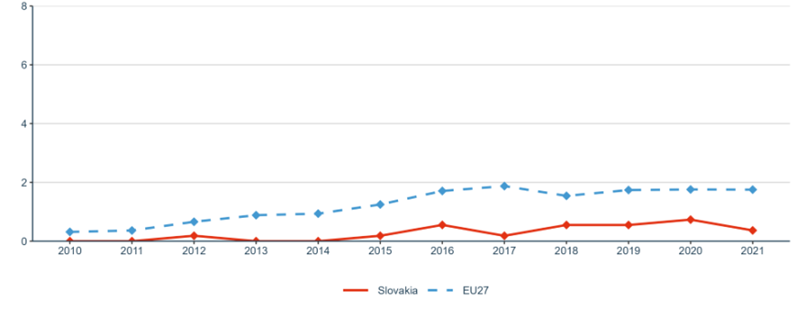
Priority 3: Amplifying access to research and innovation excellence across the Union
Sub-priority 3.1: More investments and reforms in countries and regions with lower R&I performance
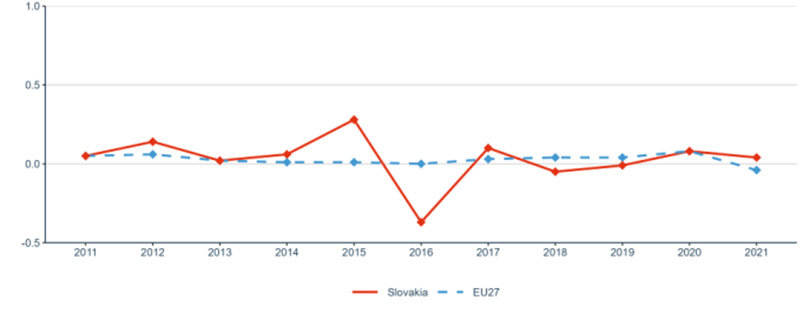
Priority 4: Advancing concerted research and innovation investments and reforms
Sub-priority 4.1: Coordination of R&I investments

